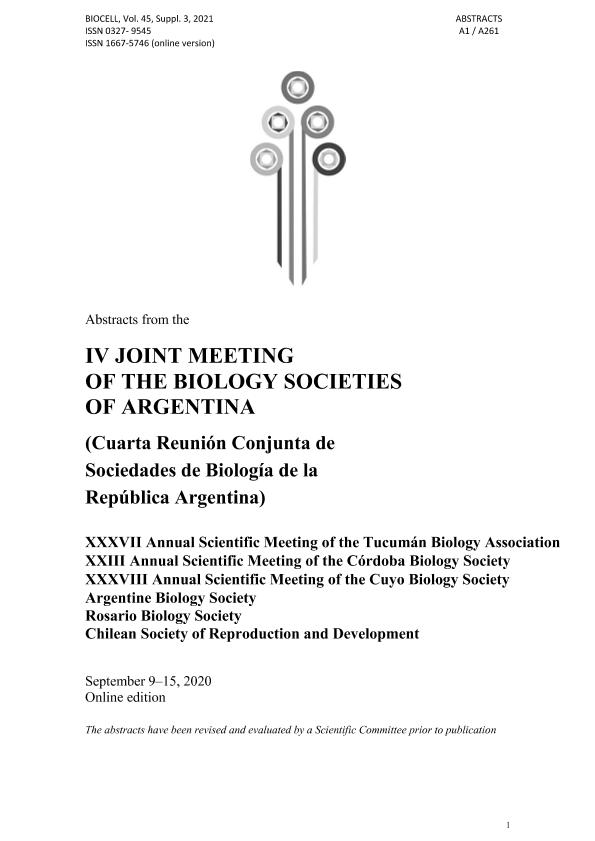Mostrar el registro sencillo del ítem
dc.contributor.author
Valero, Victoria
dc.contributor.author
Homann, Luana Micaela

dc.contributor.author
Carriere, Pedro Matias

dc.contributor.author
Novoa Díaz, María Belén

dc.contributor.author
Gentili, Claudia Rosana

dc.contributor.author
Calvo, Natalia Graciela

dc.contributor.other
Parborell, Maria Fernanda Agustina

dc.date.available
2024-03-25T12:03:23Z
dc.date.issued
2021
dc.identifier.citation
Identification of potential proteins involved in angiogenesis associated with cervical cancer using proteomics and bioinformatics approaches; IV Reunión Conjunta de Sociedades de Biología de la República Argentina; Argentina; 2020; 17-17
dc.identifier.uri
http://hdl.handle.net/11336/231401
dc.description.abstract
Angiogenesis is the growth of blood vessels from the existing vasculature and is essential in the progression of cervical cancer (CC), the fourth most common tumor in women worldwide. This process studies in search of potential biomarkers and therapeutic targets since the endothelial cells that form the abnormal tumor vasculature are characterized by changes at the protein level when are regulated by tumor and microenvironmental factors. The objective of this work was to identify potential proteins involved in the response of endothelial cells to soluble factors released by tumor cells derived from CC, using proteomics and bioinformatics approaches. We previously observed that treatment with conditioned media from CC HeLa cells (TCMs) for 24 h increases the number of endothelial HMEC-1 cells. In this work, the proteome response of HMEC-1 cells was studied underthese experimental conditions, performing a Label-Free quantitative (LFQ) mass spectrometry (MS) at the CEQUIBIEM Proteomics Center. Proteins were identified and quantified with the Proteome Discoverer software and the Uniprot database. Also, a more in-depth statistical study was performed using the Perseus software. Proteomic analysis revealed 26 proteins with increased expression levels in endothelial cells treated with TCM (P ≤ 0.05). Then, to evaluate the biological characteristics of these proteins, they were classified using the PANTHER analysis tool, according to their molecular function and biological processes. As a result of this study, catalytic activity was the most represented molecular function (11/26), followed by binding (4/26). Respect to biological processes, proteins were mainly classified into cellular processes (12/26) and energy metabolism(11/26). This analysis suggests that factors released by tumor cells mainly increase the expression of proteins involved in metabolic processes in endothelial cells. Within these proteins, the probable ATP-dependent RNA helicase DDX47 showed the greatest magnitude of change (> 2). DDX47is related to rRNA processing and ribosome biogenesis, which are processes associated with cell proliferation and cancer progression. Furthermore, ribosomal activity is also a critical regulator of metabolism. These results highlight the use of Label-Free spectrometry and bioinformatics approaches in an initial phase of discovery of potential proteins involved in cancer and suggest the potential role of DDX47 in angiogenesis associated with CC.
dc.format
application/pdf
dc.language.iso
eng
dc.publisher
Tech Science Press

dc.relation
https://www.biologia.org.ar/eventos/iv-reunion-conjunta-de-sociedades-de-biologia-de-la-republica-argentina/
dc.rights
info:eu-repo/semantics/openAccess
dc.rights.uri
https://creativecommons.org/licenses/by-nc-sa/2.5/ar/
dc.subject
CERVICAL CANCER
dc.subject
ENDOTHELIAL CELLS
dc.subject
ANGIOGENESIS
dc.subject
PROTEOME
dc.subject.classification
Bioquímica y Biología Molecular

dc.subject.classification
Ciencias Biológicas

dc.subject.classification
CIENCIAS NATURALES Y EXACTAS

dc.title
Identification of potential proteins involved in angiogenesis associated with cervical cancer using proteomics and bioinformatics approaches
dc.type
info:eu-repo/semantics/publishedVersion
dc.type
info:eu-repo/semantics/conferenceObject
dc.type
info:ar-repo/semantics/documento de conferencia
dc.date.updated
2022-11-09T15:29:59Z
dc.identifier.eissn
1667-5746
dc.journal.volume
45
dc.journal.number
3
dc.journal.pagination
17-17
dc.journal.pais
Estados Unidos

dc.journal.ciudad
Henderson
dc.description.fil
Fil: Valero, Victoria. Consejo Nacional de Investigaciones Científicas y Técnicas. Centro Científico Tecnológico Conicet - Bahía Blanca. Instituto de Ciencias Biológicas y Biomédicas del Sur. Universidad Nacional del Sur. Departamento de Biología, Bioquímica y Farmacia. Instituto de Ciencias Biológicas y Biomédicas del Sur; Argentina
dc.description.fil
Fil: Homann, Luana Micaela. Consejo Nacional de Investigaciones Científicas y Técnicas. Centro Científico Tecnológico Conicet - Bahía Blanca. Instituto de Ciencias Biológicas y Biomédicas del Sur. Universidad Nacional del Sur. Departamento de Biología, Bioquímica y Farmacia. Instituto de Ciencias Biológicas y Biomédicas del Sur; Argentina
dc.description.fil
Fil: Carriere, Pedro Matias. Consejo Nacional de Investigaciones Científicas y Técnicas. Centro Científico Tecnológico Conicet - Bahía Blanca. Instituto de Ciencias Biológicas y Biomédicas del Sur. Universidad Nacional del Sur. Departamento de Biología, Bioquímica y Farmacia. Instituto de Ciencias Biológicas y Biomédicas del Sur; Argentina
dc.description.fil
Fil: Novoa Díaz, María Belén. Consejo Nacional de Investigaciones Científicas y Técnicas. Centro Científico Tecnológico Conicet - Bahía Blanca. Instituto de Ciencias Biológicas y Biomédicas del Sur. Universidad Nacional del Sur. Departamento de Biología, Bioquímica y Farmacia. Instituto de Ciencias Biológicas y Biomédicas del Sur; Argentina
dc.description.fil
Fil: Gentili, Claudia Rosana. Consejo Nacional de Investigaciones Científicas y Técnicas. Centro Científico Tecnológico Conicet - Bahía Blanca. Instituto de Ciencias Biológicas y Biomédicas del Sur. Universidad Nacional del Sur. Departamento de Biología, Bioquímica y Farmacia. Instituto de Ciencias Biológicas y Biomédicas del Sur; Argentina
dc.description.fil
Fil: Calvo, Natalia Graciela. Consejo Nacional de Investigaciones Científicas y Técnicas. Centro Científico Tecnológico Conicet - Bahía Blanca. Instituto de Ciencias Biológicas y Biomédicas del Sur. Universidad Nacional del Sur. Departamento de Biología, Bioquímica y Farmacia. Instituto de Ciencias Biológicas y Biomédicas del Sur; Argentina
dc.relation.alternativeid
info:eu-repo/semantics/altIdentifier/url/https://www.techscience.com/biocell/v45nSuppl.3/44000/pdf
dc.conicet.rol
Autor

dc.conicet.rol
Autor

dc.conicet.rol
Autor

dc.conicet.rol
Autor

dc.conicet.rol
Autor

dc.conicet.rol
Autor

dc.conicet.nroedicion
1
dc.coverage
Nacional
dc.type.subtype
Congreso
dc.description.nombreEvento
IV Reunión Conjunta de Sociedades de Biología de la República Argentina
dc.date.evento
2020-09-09
dc.description.paisEvento
Argentina

dc.type.publicacion
Journal
dc.description.institucionOrganizadora
Sociedad Argentina de Biología
dc.source.revista
Abstract: IV Joint Meeting of The Biology Societies of Argentina. BIOCELL 2021
dc.date.eventoHasta
2020-01-15
dc.type
Congreso
Archivos asociados
